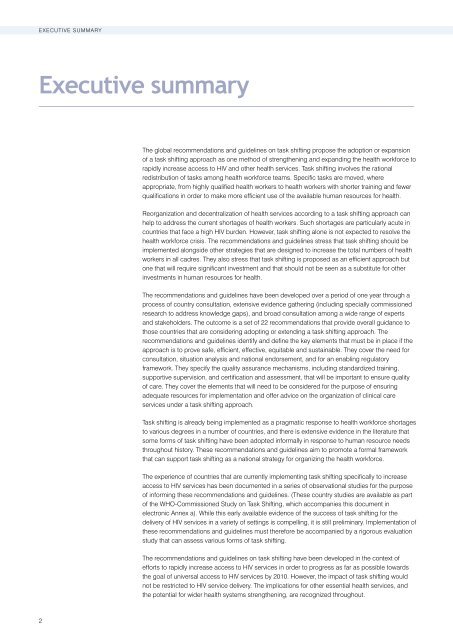Task Shifting - Global Recommendations and Guidelines - unaids
Task Shifting - Global Recommendations and Guidelines - unaids
Task Shifting - Global Recommendations and Guidelines - unaids
Create successful ePaper yourself
Turn your PDF publications into a flip-book with our unique Google optimized e-Paper software.
HEADING executive Summary<br />
Executive summary<br />
The global recommendations <strong>and</strong> guidelines on task shifting propose the adoption or expansion<br />
of a task shifting approach as one method of strengthening <strong>and</strong> exp<strong>and</strong>ing the health workforce to<br />
rapidly increase access to HIV <strong>and</strong> other health services. <strong>Task</strong> shifting involves the rational<br />
redistribution of tasks among health workforce teams. Specific tasks are moved, where<br />
appropriate, from highly qualified health workers to health workers with shorter training <strong>and</strong> fewer<br />
qualifications in order to make more efficient use of the available human resources for health.<br />
Reorganization <strong>and</strong> decentralization of health services according to a task shifting approach can<br />
help to address the current shortages of health workers. Such shortages are particularly acute in<br />
countries that face a high HIV burden. However, task shifting alone is not expected to resolve the<br />
health workforce crisis. The recommendations <strong>and</strong> guidelines stress that task shifting should be<br />
implemented alongside other strategies that are designed to increase the total numbers of health<br />
workers in all cadres. They also stress that task shifting is proposed as an efficient approach but<br />
one that will require significant investment <strong>and</strong> that should not be seen as a substitute for other<br />
investments in human resources for health.<br />
The recommendations <strong>and</strong> guidelines have been developed over a period of one year through a<br />
process of country consultation, extensive evidence gathering (including specially commissioned<br />
research to address knowledge gaps), <strong>and</strong> broad consultation among a wide range of experts<br />
<strong>and</strong> stakeholders. The outcome is a set of 22 recommendations that provide overall guidance to<br />
those countries that are considering adopting or extending a task shifting approach. The<br />
recommendations <strong>and</strong> guidelines identify <strong>and</strong> define the key elements that must be in place if the<br />
approach is to prove safe, efficient, effective, equitable <strong>and</strong> sustainable. They cover the need for<br />
consultation, situation analysis <strong>and</strong> national endorsement, <strong>and</strong> for an enabling regulatory<br />
framework. They specify the quality assurance mechanisms, including st<strong>and</strong>ardized training,<br />
supportive supervision, <strong>and</strong> certification <strong>and</strong> assessment, that will be important to ensure quality<br />
of care. They cover the elements that will need to be considered for the purpose of ensuring<br />
adequate resources for implementation <strong>and</strong> offer advice on the organization of clinical care<br />
services under a task shifting approach.<br />
<strong>Task</strong> shifting is already being implemented as a pragmatic response to health workforce shortages<br />
to various degrees in a number of countries, <strong>and</strong> there is extensive evidence in the literature that<br />
some forms of task shifting have been adopted informally in response to human resource needs<br />
throughout history. These recommendations <strong>and</strong> guidelines aim to promote a formal framework<br />
that can support task shifting as a national strategy for organizing the health workforce.<br />
The experience of countries that are currently implementing task shifting specifically to increase<br />
access to HIV services has been documented in a series of observational studies for the purpose<br />
of informing these recommendations <strong>and</strong> guidelines. (These country studies are available as part<br />
of the WHO-Commissioned Study on <strong>Task</strong> <strong>Shifting</strong>, which accompanies this document in<br />
electronic Annex a). While this early available evidence of the success of task shifting for the<br />
delivery of HIV services in a variety of settings is compelling, it is still preliminary. Implementation of<br />
these recommendations <strong>and</strong> guidelines must therefore be accompanied by a rigorous evaluation<br />
study that can assess various forms of task shifting.<br />
The recommendations <strong>and</strong> guidelines on task shifting have been developed in the context of<br />
efforts to rapidly increase access to HIV services in order to progress as far as possible towards<br />
the goal of universal access to HIV services by 2010. However, the impact of task shifting would<br />
not be restricted to HIV service delivery. The implications for other essential health services, <strong>and</strong><br />
the potential for wider health systems strengthening, are recognized throughout.

















